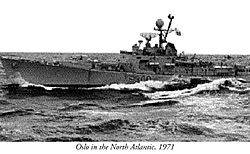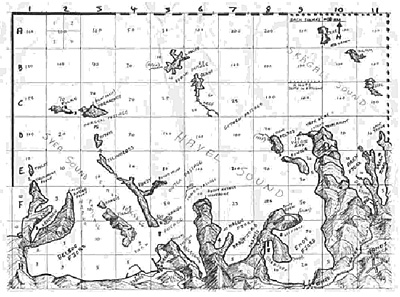 Oslo in the North Atlantic, 1971
Oslo in the North Atlantic, 1971
Location:
A fictional area of coastline in northern waters during the late 1980s, during a NATO-Soviet general war. The scenario starts at 0100 hours local time.
NATO Operational Situation:
So far, Soviet naval forces have remained close to their own airbases. This has forced NATO to fight them on their own terms.
One week ago, NATO vessels on an offensive patrol into the Soviet-dominated zone clashed with a Soviet surface force. During this engagement, the cruiser Slava suffered a serious machinery breakdown and engine room fire after a near miss. She is known to have taken shelter in Darfjord while repairs were made. Several attempts to attack her with aircraft have failed because of the strong air defenses of the area. Intelligence sources have indicated that she is almost ready to sail. At least one other vessel has been dispatched to escort her, but has not yet arrived. At least one coastal frigate is guarding Emoy Fjord.
Seventy-two hours ago, the weather blew up to hurricane strength. Weather reports show the eye of the storm is about to pass over the area. In this period of low visibility and rain, it is expected that most Soviet aircraft in the area will be unable to operate. Unfortunately, because of the storm having now moved south, it is over the NATO air bases and preventing them from operating. In the local area, however, it is expected helicopters will be able to operate at low to very low altitudes.
Intelligence reports that during the period the eye is over the area, Slava will either be relocated or leave the area completely. They are uncertain which will apply, but are positive that the ship will move from its current location. It is understood that a small Soviet escort vessel may have entered Darfjord to shelter from the storm. You should, however, be on the alert for all forms of hostile activity. As best is known, thereare no mines in the area.
NATO Orders:
Your force, made up of elements of the Northern Patrol, will make their way to Havel Sound, locate Slava and sink her. They must then withdraw rapidly so they are out of these restricted waters when the second part of the storm arrives. It is also desirable that they be as far back under NATO air cover as possible when the weather clears.
The operation needs to be carried out and the ships withdrawn swiftly. Any cripples should have their crews taken off and the ships scuttled rather than risk the rest of the force.
Your priority is to locate and sink Slava, however, you may use your discretion to engage any other enemy vessels you should encounter.
NATO Forces:
The Norwegian frigate Oslo is with this force, since the captain is very familiar with the area and is capable of acting as a pilot. She should lead the way in any restricted waters.
Duquesne. (Flag) French Suffren class DDG.
Cornwall. British Type 22, Batch 3 FF
Oslo. Norwegian Oslo class FF
This might not be the force an Admiral would deliberately choose for such a difficult mission. Nevertheless, they are the only ships close enough to call on. No subs are available due to operations elsewhere and recent losses.
Soviet Operational Situation:
Since the recent outbreak of war with NATO, Soviet Naval forces have remained under their own air cover. This has forced NATO to fight them on our terms. One week ago, a clash with NATO vessels took place. During the engagement, the cruiser Slava suffered a machinery breakdown and fire after a near miss. He has taken shelter in Darfjord while repairs are made. NATO attempts to attack him with aircraft have failed because of the strong air defenses of the area and bravery of Soviet pilots.
Seventy-two hours ago, the weather blew up to hurricane strength. Met. reports show the eye of storm about pass over area today. In this period of low visibility and rain, it is expected that Soviet aircraft in area will unable to operate. Fortunately, the storm is now over the NATO air base, preventing the capitalist reactionary pigs from carring out sorties either.
Slava is almost ready to sail for home, but he needs a few more days so the crew can finish installing new machinery. Although the storm keeps NATO away, it is considered wise to move him to another location while the second half of the storm passes and emergency repairs are completed. Gar Fjord has been inspected and selected. It is very restricted and will make air attack even more difficult for Western pilots. Slava is departing Darfjord at 0130 but only capable of moving at half speed.
Admiral Zakharov (Udaloy-class DD) has been dispatched with spare parts needed for the repairs. He has not yet arrived, but has been told rendezvous with Slava in Gar Fjord. Admiral Zakharov is at point A11, 0100 and can proceeding straight to Gar Fjord. Priority is delivery of the spare parts to Slava but can be diverted to escort him if needed.
A Krivak I-class frigate and a Grisha II-class corvette are arriving in Emoy during the storm to shelter. They can be used to patrol, or to directly escort Slava during his move to Gar Fjord.
Soviet Forces:
Slava: Slava class missile cruiser. Machinery defects restrict her to 50% speed, but all other systems are operational. She has a Ka-25 Hormone B embarked.
Admiral Zakharov: Udaloy class destroyer. She is carrying spare parts for Slava. She has two Ka-27 Helix A embarked. Retivyy: Krivak I class frigate. His two RBU 6000 have been removed and replaced by a PB&SB(4)2 Kh-35 Uran [SS-N-25].
Izumrud. Grisha II class corvette. KGB-manned.
Soviet-Controlled Merchant Vessels:
Several large and small ships are also sheltering in the area.
Akademik Tupolev: Roll on/Roll off, ship, Medium signature, 3200 grt (36 dp), 17 kts. Vessel is not armed. She is anchored in Darfjord.
Stakhanovets Kotov: Ro-flo-ship, Medium signature, 4300 grt (47 dp), 14 kts. Vessel is not armed. She is anchored in Darfjord.
Akhtuba: Project 1552 [Sofia class] naval tanker, Medium signature, 132, 320 t std, 17 kts. Vessel is not armed. She is anchored in the center of Emoy Fjord.
Boris Butoma: Bulk ore carrier, Large signature, 63,200 grt (362 dp), 15 kts. She is anchored 2 miles west of Akhtuba.
Referee Notes:
If possible, so that Admiral Zakharov can be run separately, the Soviet forces should have more than one player. If the patrol ships were to operate separately, it would be desirable for them to also have a separate commander.
This only applies to the NATO side if the ships should separate. However, the importance of keeping together should be impressed upon the NATO player. Nonetheless, it will not matter if more than one player is present to control the individual ships.
Referee-Controlled Merchant Vessels:
Mitzi Witzhof: A small local cargo vessel, Small signature, 1000 grt (14 dp) 15 kts. This ship has been sheltering in Vaslos Bay. (D9) She will leave there at 0100 and attempt to make it to shelter in Varn (H5) before the storm returns.
Belgog XIV: Local fishing trawler Small signature, 250 grt (4 dp), 12 kts. This vessel has left Badsos. At 0100 she is in G5 on passage to the Darfoss refrigeration plant with a full load of fish getting dangerously close to 'use by' date.
Kremlin Kavkaz: Bulk Ore Carrier, 63,200 grt (362 dp), 15 kts. At 0100 this ship is in A5, steaming southwest. It has been lost in the storm for 48 hours and is moving slowly, having suffered severe storm damage. She has suffered several flooding and engineering criticals, and can only proceed at one-quarter speed (4 kts). Beacuse of wartime security, she is not broadcasting a radio distress call, but will attempt to contact any ship that she sights visually.
Her navigation radar is operating and the navigator has just picked up Lanloy Island. Having worked out where they are, he will attempt to make it into Emoy Fjord via Havel Sound.
Environment:
Low and dense overcast. Cloud base 100m. Morning twilight is at 0320. Dawn is at 0450. Dusk at 2315.
Visibility at scenario start 5%, increasing to 10% at twilight and 40% at dawn. Sea State is 3. Wind is calm. Rain is constant in the area, but varies from intermittent to light to medium intensity. Default is assumed to be light. Visibility is one level lower in medium rain, and one level higher in intermittent rain.
The referee should prepare several shapes D6*1000 yards across. These can be circles, ovals, rectangles, or irregular shapes. Each three-minute tactical turn, there is a 10% chance of a shape appearing on the map. It has a 50% chance of being either an area of intermittent or medium rain, with associated visibility effects. The areas will move east (090°T) at a speed of 20 knots.
As described in 4.2.5.2, all surface radar ranges are halved if there is land in the line of sight with the contact. If it becomes important, the coastline colour is generally black, with white snow patches.
Sonar conditions are degraded by 50% within 5nm of any of the reefs shown. Sonar contact cannot be made or maintained if a direct line between searcher and target passes over a reef area, or naturally, through land. As mentioned in SITREP #15 (April 99), the TARH seekers used by the majority of SSMs will not distinguish ships within 5 nm of shore from the ship itself. Missiles with TARH seekers fired at ships within 5 nm of shore will instead lock onto shore and explode somewhere inland. Only TARH seekers are affected. There are no shore defenses other than at Aamos airfield, which has SAMs and radars, but should not figure in this operation.
It should be impressed upon players that the situation is one of dull, nasty, dark weather with very poor visibility and the threat of the hurricane resuming.
In fact, the players are not to be told anything other than the meteorological report that expects the eye of the Hurricane to pass over. Helicopters may fly, but only at Very Low, or Low altiude.
Map:
The area is, as already stated, a fictional one. The map is gridded in ten nm squares, purely to give players a visual estimation of distances. Depths shown are in fathoms. The water in Darfjord is therefore 60 feet deep. F4 in the Fonoy Passage is therefore 30 feet deep. Players and referee must check ships draught. Any ship operating in an area of 5 or less fathoms and travelling at more than 2/3rds speed will roll a die for each Intermediate Turn and will strike an uncharted rock on the roll of '0'. Ship will suffer light damage (10% points loss) and will lose the use of sonar for the rest of the game. The heavy black edging represents the area via which NATO ships must enter or exit. The dotted border represents the area via which Soviet ships must enter or exit.
Map

BT
Back to The Naval Sitrep #19 Table of Contents
Back to Naval Sitrep List of Issues
Back to MagWeb Master Magazine List
© Copyright 2000 by Larry Bond and Clash of Arms.
This article appears in MagWeb (Magazine Web) on the Internet World Wide Web.
Other military history articles and gaming articles are available at http://www.magweb.com